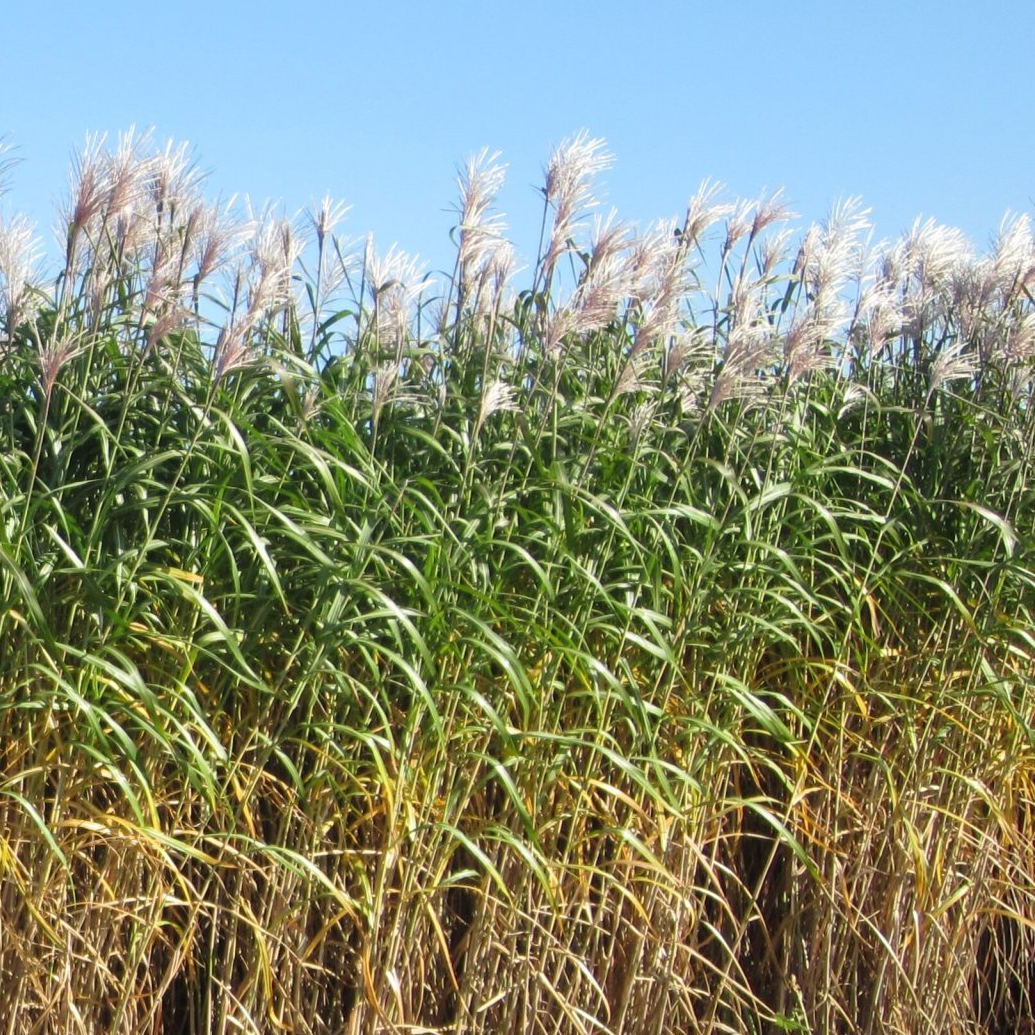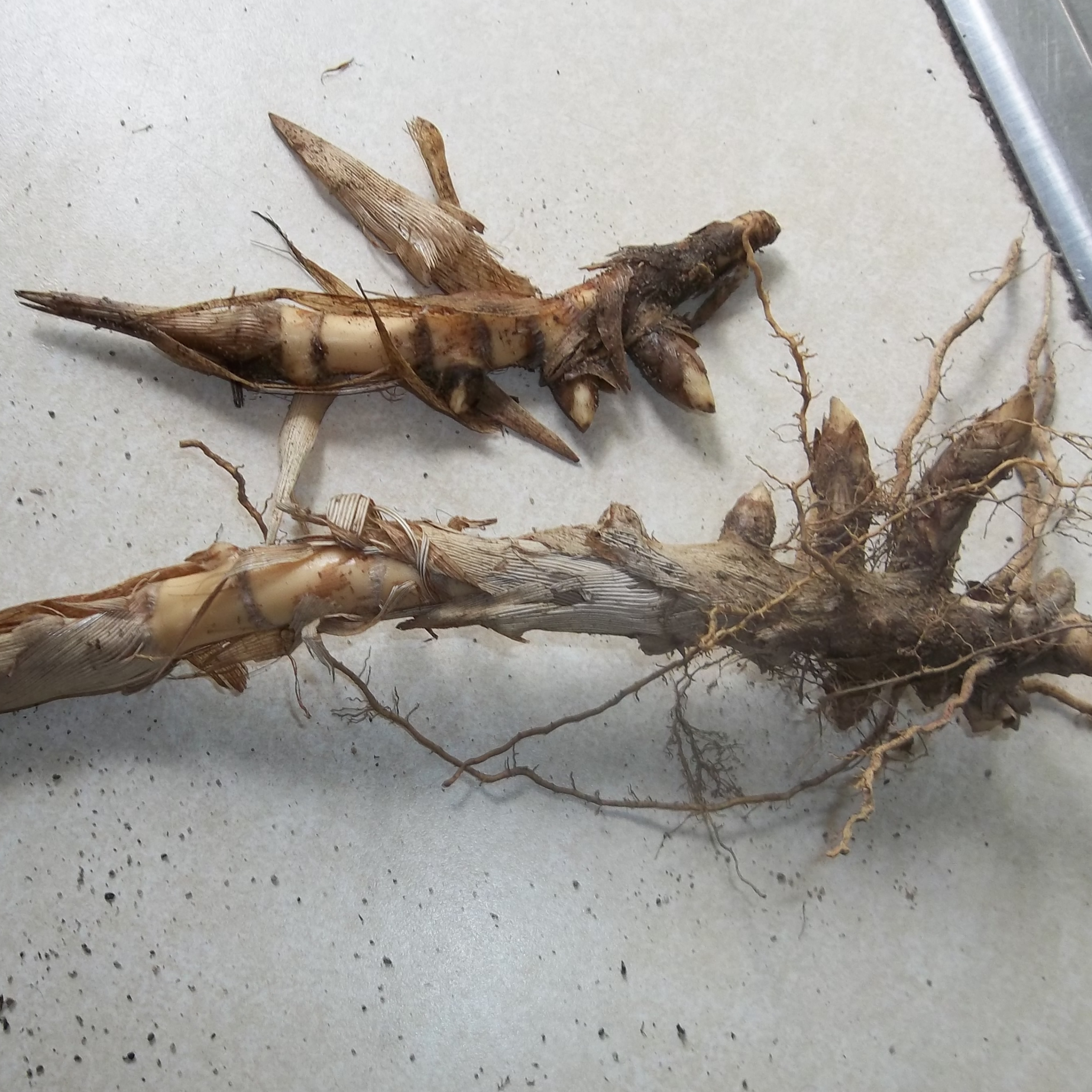Frequently Asked Questions
FAQ:
- I want to make a hedge of Miscanthus Giganteus. How close do I space the plants?
- I want to plant a 100 ft. hedge, how much will it cost?
- How quickly does Miscanthus Giganteus reach 12-14 feet?
- How and where do I plant Miscanthus Giganteus?
- There are several suppliers of Miscanthus Giganteus, why should I buy from PotterVilla Pastures?
- Do you give discounts on large orders?
- How much is shipping on Miscanthus Giganteus?
- When do you ship Miscanthus Giganteus and why only bare root?
- Once I receive my order how do I care for it?
- Can I pick up my order?
- What is your guarantee?
PLANTING

Q: I want to make a hedge of Miscanthus Giganteus. How close do I space the plants?
A: You would space the plants as follows:
Single rhizomes: 1′ apart
½ gal divisions: 1.5 – 2′ apart
1 gal divisions: 2.5 – 3′ apart
*Will take 2-3 years for plants to touch one another, planting staggered rows will help make a fuller planting sooner.
Learn more on our Planting Instructions page.
A: For a 100′ planting you would need either:
100 single rhizomes, or
50 ½ gal divisions, or
34 1 gallon divisions
For the latest pricing, see our Miscanthus Giganteus store page. Or Contact Us for pre-order details.
A: It can take up to 3 years after planting field divisions for the plant to reach full height (rhizomes 2-3 year, ½ gal. 1-3 years, 1 gal 1-2 years). The difference in ½ and gallon size plants is not only height, but you get more width with larger root divisions.
All plants will appear the first year, with possibly only 1-3 stems per plant. Each stem produces many leaves, but it takes a few years for the plant to appear full. When grass is divided, it takes some of the vigor from the plant. Much like any perennial, it takes time to re-establish. Expect first year heights of 2-4′ from single rhizomes, 3-6′ from 1/2 gal divisions, and 6-8′ from 1 gal divisions.
Moisture and warmth are the two factors that greatly affect the height of the plant. In favorable conditions you may have larger plants the first year, in unfavorable conditions your plants could be shorter. By the third year after planting you should have full height.
A: See our Planting Information page for detailed information on how best to plant your new Miscanthus Giganteus.
STORE & ORDERS

Q: There are several suppliers of Miscanthus Giganteus. Why should I buy from PotterVilla Pastures?
A: There are 3 main types of starter plants of Miscanthus Giganteus. We sell what we believe to be a good form of starter plant, rhizomes and field divisions. We harvest our roots and hand inspect them, removing the older, less vigorous parts of the divisions, selling you the best root material. Other producers do not always show just what size plant you are getting. Be aware that it’s the rhizome size that matters, not how much feeder root you get. Larger rhizomes mean larger plants and a better survival rate. If competitors offer lower shipping, it’s very likely their plants are smaller. We also stand behind what we sell.
A: Yes, prices are reduced the more you buy. See our Miscanthus Giganteus store page for specific pricing information. If desiring more than 1000 plants, contact us for a quote.
A: We commit to sending only quality plants. If you are not happy with the quality of your plants you may return them within 2 weeks of shipment. Shipping costs to and from the buyer are not reimbursed. The original cost of the plant will be reimbursed. Any guarantee after receiving the plants is limited. We simply cannot offer a blanket replacement plan when we do not know how the buyer will care for the plants. We also are unable to control the natural conditions of the environment. These are living things and must have the care suggested to survive. If you have questions or issues, please do contact us with them. At times we will replace plants, but only if we feel it may have been an issue on our end. Each case will be handled as the need occurs. In our view we are only successful if we have helped you be successful. It is not a matter of just making money, our goal is to help others succeed and we will do all we can to assure that.
SHIPPING & CARE

A: Our root harvest normally starts in October. Fall shipping starts soon after. We do not recommend fall planting for states in zone 4 as there is not a long enough time frame to plant before the ground freezes. Fall shipments start soon after harvest and we are able to ship even in cold temperatures as this is a very cold tolerant plant. We only ship in the fall until sold out.
We have tested it and found it to survive -20 degree air temps just fine, though normally we do not ship when temps are below 20 degrees. Many warmer climates will do well to plant in late fall and early spring when temps are lower and moisture higher. Colder states should expect shipments even when the weather is cool. Remember, this is a bare root plant and will stay more dormant in cooler temps. Plants may arrive sooner than your expected planting time. They will easily store in a cool, dark place, such as a garage or barn, or even in insulated coolers, keeping them in the packaging they arrive in. Spreading out shipments in this fashion helps us not to have to hire extra help for this purpose and helps keep pricing lower for you.
Bare root plants can only be sent while the plant is dormant, or not growing. If planting in the spring it is best to plant in early to mid season for your area, which differs from state to state. Roots may grow even while the air temperatures are cool, as the soil temps warm, and so long as the ground is not frozen. The plant will then have a greater feeder root system which takes up the nutrient and water needed and it will be much more acclimated and ready to withstand the rigors of heat and drought which can occur in summer.
Divisions cannot be taken until the plant has gone dormant in mid to late October. As the plant goes dormant it stores the nutrient it has manufactured during the growing season, which is necessary for the plant to have vigor the next year. Plants can be shipped through mid to late November most years. Fall planting allows for some root growth while soil temperatures are above freezing, and plants should be well acclimated and ready to push forth growth the following summer. (You will not see top growth of the plant when planting in fall, until late in the following spring.)
A: Bare root Miscanthus Giganteus is packed in moistened peat moss or other absorbent materials and held in plastic bags. This grass is similar to other root grown plants, like bulbs, and peonies. It will survive fine in the environment it is shipped in. Once you receive your plants you should check the peat moss/packaging for moisture. It should be moist but not sopping wet. If you think it needs water, mist it with a hose, or sprinkle lightly with a can. Do not let too much water sit in the bag, as the roots can rot.
It is best to plant your grass as soon as possible. However, you can hold your grass roots for a few weeks before planting, with little detriment to the plant. Simply keep an eye on the moisture every few days. You may poke a few holes in the bags for air movement so the roots do not become moldy. Store the roots in a cool place out of the sun, too much warmth or sun will cause the roots to grow. Some green shoot growth is not a problem, but eventually the plant needs good soil and water. If you wish to keep them dormant for a period of time, they can be refrigerated. If temperatures are extremely cold, protect roots in an insulated cooler, or by wrapping them in a tarp, etc. Keeping the roots at a more constant temperature, rather than allowing a freeze-thaw cycle, is better for the plant.
A: At this time we don’t offer pickup at the farm, but for large orders or special circumstances please Contact Us.
A: Please see our Store page for specific pricing.
